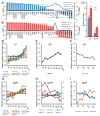Carcass and Meat Quality Characteristics and Changes of Lean and Fat Pigs After the Growth Turning Point
- PMID: 40807656
- PMCID: PMC12345986
- DOI: 10.3390/foods14152719
Carcass and Meat Quality Characteristics and Changes of Lean and Fat Pigs After the Growth Turning Point
Abstract
Pork is a major global source of animal protein, and improving both its production efficiency and meat quality is a central goal in modern animal agriculture and food systems. This study investigated post-inflection-point growth patterns in two genetically distinct pig breeds-the lean-type Yorkshire pig (YP) and the fatty-type Qingyu pig (QYP)-with the aim of elucidating breed-specific characteristics that influence pork quality and yield. Comprehensive evaluations of carcass traits, meat quality attributes, nutritional composition, and gene expression profiles were conducted. After the growth inflection point, carcass traits exhibited greater variability than meat quality traits in both breeds, though with distinct patterns. YPs displayed superior muscle development, with the longissimus muscle area (LMA) increasing rapidly before plateauing at ~130 kg, whereas QYPs maintained more gradual but sustained muscle growth. In contrast, intramuscular fat (IMF)-a key determinant of meat flavor and texture-accumulated faster in YPs post inflection but plateaued earlier in QYPs. Correlation and clustering analyses revealed more synchronized regulation of meat quality traits in QYPs, while YPs showed greater trait variability. Gene expression patterns aligned with these phenotypic trends, highlighting distinct regulatory mechanisms for muscle and fat development in each breed. In addition, based on the growth curves, we calculated the peak age at which the growth rate declined in lean-type and fat-type pigs, which was approximately 200 days for YPs and around 270 days for QYPs. This suggests that these ages may represent the optimal slaughter times for the respective breeds, balancing both economic efficiency and meat quality. These findings provide valuable insights for enhancing pork quality through precision management and offer theoretical guidance for developing breed-specific feeding strategies, slaughter timing, and value-added pork production tailored to consumer preferences in the modern food market.
Keywords: carcass traits; growth turning point; meat quality; pork.
Conflict of interest statement
The authors declare that the research was conducted in the absence of any commercial or financial relationships that could be construed as potential conflicts of interest.
Figures




Similar articles
-
Exploring the impact of fatty acid composition on carcass and meat quality in Bos taurus indicus influenced cattle.J Anim Sci. 2024 Jan 3;102:skae306. doi: 10.1093/jas/skae306. J Anim Sci. 2024. PMID: 39383295
-
Effects of maternal inflammation on growth performance, carcass characteristics, and meat quality of offspring pigs.J Anim Sci. 2024 Jan 3;102:skae215. doi: 10.1093/jas/skae215. J Anim Sci. 2024. PMID: 39066604 Free PMC article.
-
Evaluation of the residual feed intake on carcass and meat quality traits of Nellore bulls: a biochemical and molecular approach.J Anim Sci. 2025 Jan 4;103:skaf148. doi: 10.1093/jas/skaf148. J Anim Sci. 2025. PMID: 40322911
-
The Black Book of Psychotropic Dosing and Monitoring.Psychopharmacol Bull. 2024 Jul 8;54(3):8-59. Psychopharmacol Bull. 2024. PMID: 38993656 Free PMC article. Review.
-
Corticosteroids for the treatment of Duchenne muscular dystrophy.Cochrane Database Syst Rev. 2016 May 5;2016(5):CD003725. doi: 10.1002/14651858.CD003725.pub4. Cochrane Database Syst Rev. 2016. PMID: 27149418 Free PMC article.
References
Grants and funding
- 2024YFF1000201/National Key Research and Development Program of China
- 32421005/National Natural Science Foundation of China
- 2021YFYZ0007, 2021ZDZX0008, 2024NSFSC0298/Sichuan Science and Technology Program
- SCCXTD-2025-8/Pig Industry Technology System Innovation Team of Sichuan Province
- CARS-35/China Agriculture Research System
LinkOut - more resources
Full Text Sources

